Introduction to Counter Surfing in Dogs

Counter surfing is a common behavior problem in dogs where they jump up on countertops or tables to grab food or other items. This can be frustrating for dog owners and potentially dangerous for the dogs themselves.
Dogs engage in counter surfing for various reasons, including their natural instinct to scavenge for food and their desire for attention. Food-driven dogs may be motivated to counter surf because they smell something enticing on the counter. Attention-seeking dogs may learn that jumping on the counter gets them noticed.
To prevent counter surfing, it is important to identify the common triggers that lead to this behavior. The placement of food and smells on countertops can be a strong temptation for dogs. Additionally, the accessibility of countertops and tables plays a role, as dogs are more likely to jump up if they can easily reach the desired items.
Preventive measures such as clearing countertops and tables of food and using deterrents and barriers can help in reducing counter surfing incidents. Training techniques, such as teaching the "Leave it" command and positive reinforcement for desired behavior, can also be effective in curbing this behavior.
Consistency and reinforcement are key in addressing counter surfing. Establishing a consistent routine and rewarding alternative behaviors can help dogs understand what is expected of them.
Managing temptations by properly storing and disposing of food, as well as keeping countertops clean and clear, can diminish the appeal of jumping up on counters for dogs.
Addressing underlying issues, such as separation anxiety or boredom, can also help in preventing counter surfing. These issues should be addressed through appropriate training and providing mental and physical stimulation for the dog.
By preventing counter surfing, dog owners can ensure the safety of their pets and create a more peaceful home environment. Consistent training and management techniques are essential for ongoing success in curbing this behavior.
What is counter surfing?

Counter surfing refers to the behavior displayed by dogs when they jump up on countertops or tables in order to access food or other items. It is a common problem faced by dog owners, especially those with food-driven or curious canine companions.
When a dog engages in counter surfing, they may snatch food or treats that have been left unattended, or they may simply explore and investigate what's on the counter. This behavior can be frustrating and potentially dangerous, as it can lead to the ingestion of toxic substances or the destruction of items.
Understanding the motivation behind counter surfing is crucial in effectively addressing the issue. Dogs may engage in this behavior due to their natural instinct to scavenge for food, or because they are seeking attention from their owners. By identifying the underlying reasons for counter surfing, owners can take appropriate measures to prevent and redirect this behavior.
Why do dogs engage in counter surfing?
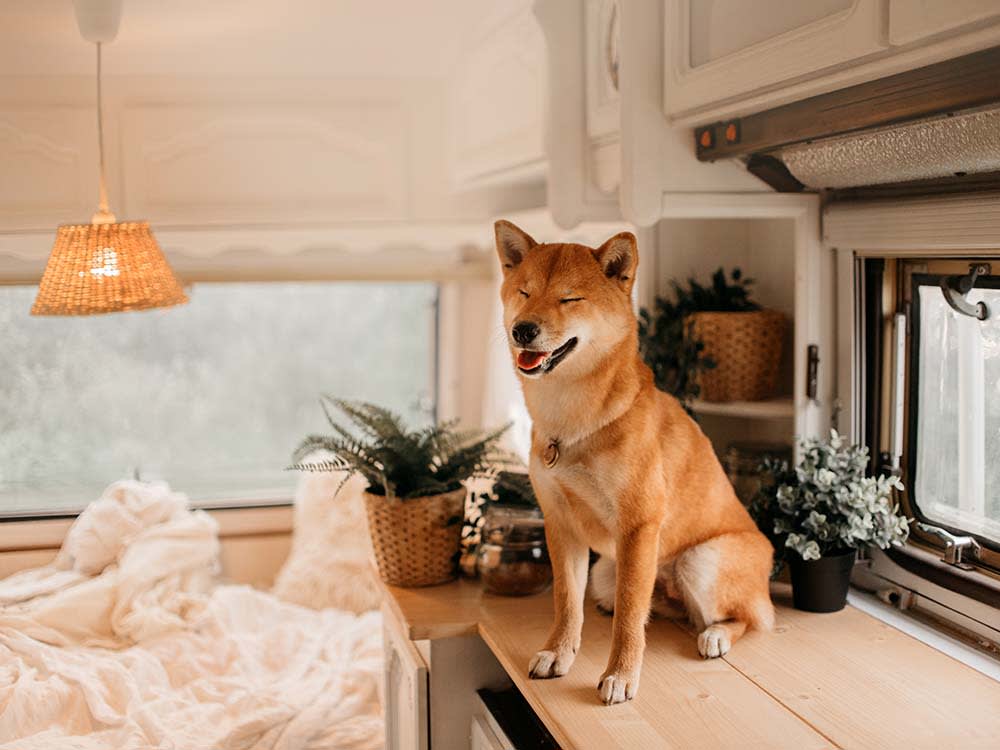
Counter surfing is a common behavior among dogs, and there are several reasons why they may engage in this behavior. One primary motivation is the desire for food. Dogs have a strong sense of smell, and the enticing aroma of food can be irresistible to them. Dogs are opportunistic creatures and will take advantage of any chance to grab a tasty treat.
Another reason for counter surfing may be attention-seeking behavior. Dogs are social animals and crave attention from their owners. If they have learned that counter surfing results in attention or a reaction from their humans, they may continue this behavior to seek out that attention, even if it is negative.
It's essential to understand these motivations behind counter surfing to effectively prevent and address the behavior. By identifying the triggers and underlying causes, we can implement preventive measures, training techniques, and address any potential issues such as separation anxiety or boredom that may contribute to counter surfing.
Understanding Your Dog's Motivation

Understanding Your Dog's Motivation:
When it comes to counter surfing, it is important to understand the underlying motivation that drives dogs to engage in this behavior. By understanding your dog's motivations, you can better address the issue and find appropriate solutions.
One common motivation for counter surfing is food-drive. Dogs with a strong desire for food are more likely to take advantage of any opportunity to snatch tasty treats from countertops or tables. These dogs have learned that they can reap rewards from their thievery, leading them to engage in the behavior repeatedly.
Another motivation for counter surfing can be attention-seeking behavior. Some dogs have learned that jumping up on the counter and stealing objects will elicit a response from their owners. Whether it's scolding, chasing, or trying to retrieve the stolen item, the attention received reinforces the behavior.
Understanding these motivations can help you tailor your approach to preventing counter surfing. For food-driven dogs, ensuring that food is properly stored and inaccessible can reduce the temptation. For attention seekers, providing mental and physical stimulation, as well as teaching alternative behaviors, can redirect their focus.
By understanding your dog's motivations, you can address the root causes of counter surfing and work towards finding effective solutions.
Food-driven dogs and counter surfing
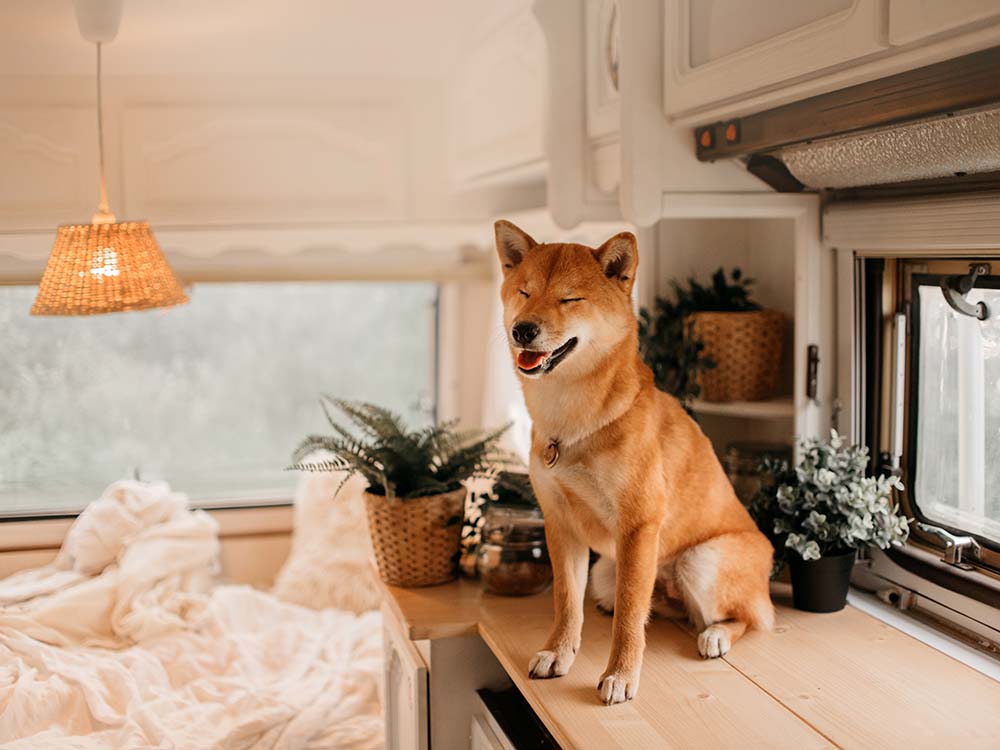
Food-driven dogs are particularly prone to engaging in counter surfing behavior. These dogs have an insatiable desire for food and will go to great lengths to satisfy their cravings. Counter surfing provides them with easy access to tempting treats and leftovers that are left unattended on kitchen countertops or tables.
For food-driven dogs, the allure of a potential snack is too hard to resist. The scent of food wafting through the air is like a magnet, drawing them towards the source. Their motivation is purely driven by their need for nourishment and the irresistible smells that emanate from the countertops.
To prevent counter surfing in food-driven dogs, it is essential to ensure that all food items are securely stored and out of reach. This includes properly sealing containers, covering garbage bins, and being mindful of where food is left unattended. Additionally, providing these dogs with mentally stimulating alternatives, such as puzzle toys or interactive feeders, can help redirect their focus away from the countertops and onto more appropriate activities.
Attention-seeking behavior and counter surfing
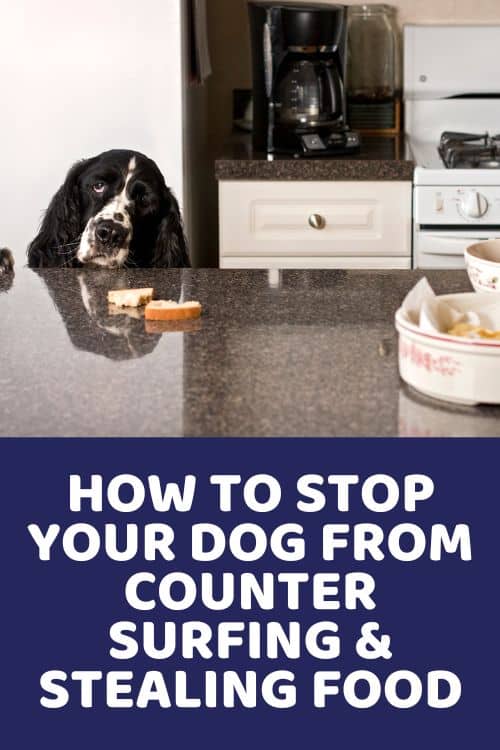
Attention-seeking behavior is another motivation that can drive dogs to engage in counter surfing. Some dogs have learned that by jumping up on countertops or tables and stealing food, they are able to gain attention from their owners. Whether it's a raised voice, chasing after the dog, or even laughter, any form of attention can reinforce this behavior.
Dogs are social creatures and crave interaction with their owners. If they have learned that counter surfing leads to attention, they will continue to engage in this behavior in an attempt to receive the desired response. This can become a negative cycle, as the dog learns that counter surfing equals attention, and will repeat the behavior whenever they are seeking interaction.
To address this issue, it's important to provide your dog with ample attention and mental stimulation throughout the day. Engage in regular play sessions, provide puzzle toys, and spend quality time together. By fulfilling their need for attention in positive ways, you can reduce the likelihood of attention-seeking behaviors such as counter surfing.
Identifying Common Triggers
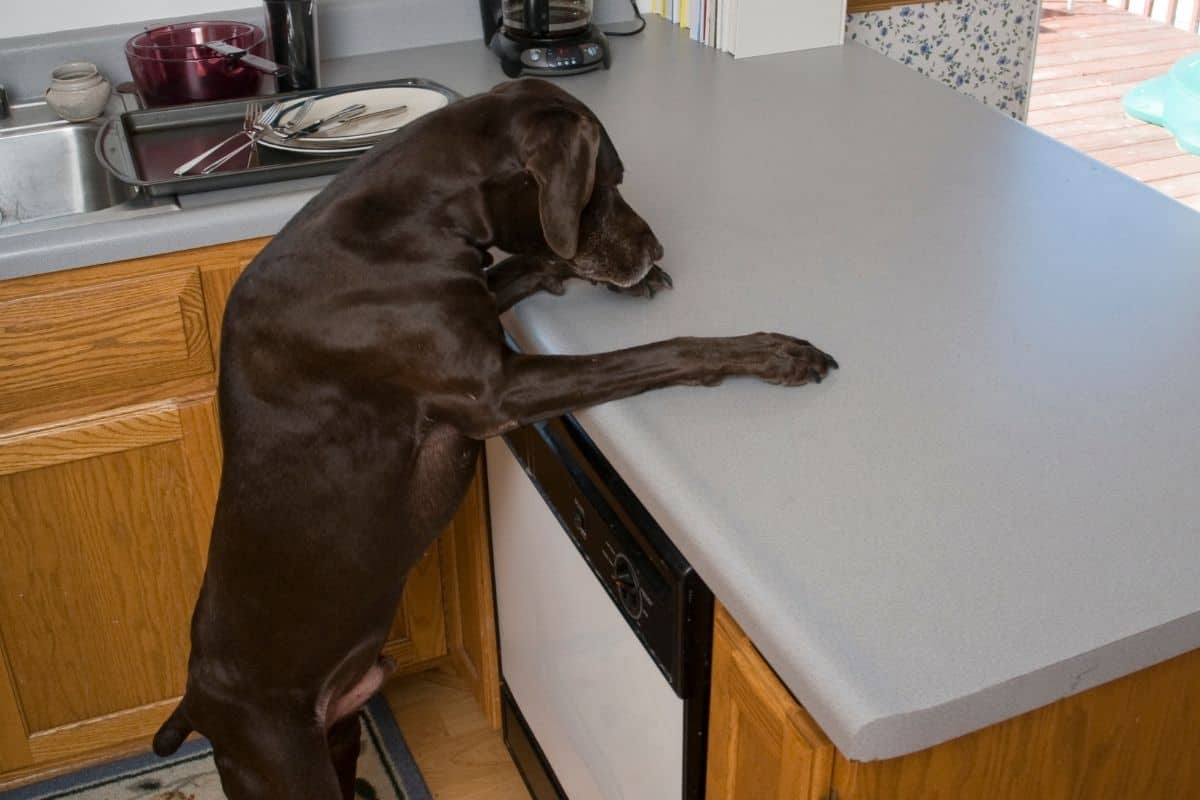
Identifying Common Triggers
One key step in preventing counter surfing in dogs is to identify the common triggers that entice them to explore the countertops and tables. These triggers can vary from the placement of food and smells to the accessibility of the elevated surfaces.
The placement of food and smells can be a strong temptation for dogs. If there are frequently enticing aromas coming from the counters or tables, your dog may be more likely to engage in counter surfing. This includes leaving food unattended or having food scraps within reach.
The accessibility of the countertops and tables also plays a role. If your dog can easily access these surfaces, they are more likely to explore them. This can happen if there are no physical barriers or if the dog has learned to jump onto them.
By understanding these common triggers, you can take proactive measures to minimize them. This may involve rearranging your kitchen or dining area, storing food securely and out of reach, and creating barriers to prevent easy access. By removing these temptations, you can effectively reduce the occurrence of counter surfing in your dog.
Placement of food and smells
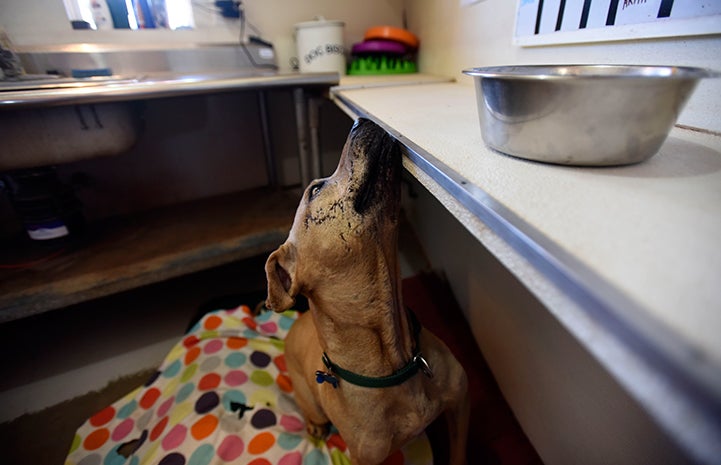
Placing food and smells in strategic locations can significantly impact your dog's temptation to counter surf. Dogs have an incredibly keen sense of smell, and they are naturally drawn to areas with enticing scents. Therefore, it is crucial to be mindful of where you position food and other aromatic items in your home.
Avoid leaving food unattended on countertops or tables, especially if it's within reach of your pup. Instead, store perishable items securely in the fridge or seal them in airtight containers. Additionally, be mindful of the smells that may linger in your kitchen after cooking, like bacon or other delicious aromas. These scents can linger and entice your dog to explore your countertops.
Furthermore, consider keeping garbage cans securely closed and out of reach. The odors of discarded food can be irresistible to your furry friend, leading to unwanted counter surfing behavior. By controlling the placement of food and smells in your home, you can minimize the temptation for your dog and reduce the likelihood of them exploring your countertops.
Accessibility of countertops and tables

Accessibility plays a crucial role in determining whether dogs will be tempted to engage in counter surfing. Countertops and tables that are easily within a dog's reach are more likely to become a target for their exploring paws and curious noses.
Low countertops or tables positioned near areas where the dog spends most of its time, such as the kitchen or dining room, can be especially enticing. Additionally, countertops with ledges or edges that dogs can use to gain leverage and access to food are prime targets.
It is important to assess the accessibility of these surfaces and make necessary adjustments to prevent dogs from reaching them. A simple solution could be rearranging furniture to block access or using baby gates to limit a dog's movement in certain areas.
By addressing the accessibility of countertops and tables, dog owners can significantly reduce the likelihood of counter surfing incidents and create a safer, more manageable environment for both themselves and their furry friends.
Preventive Measures
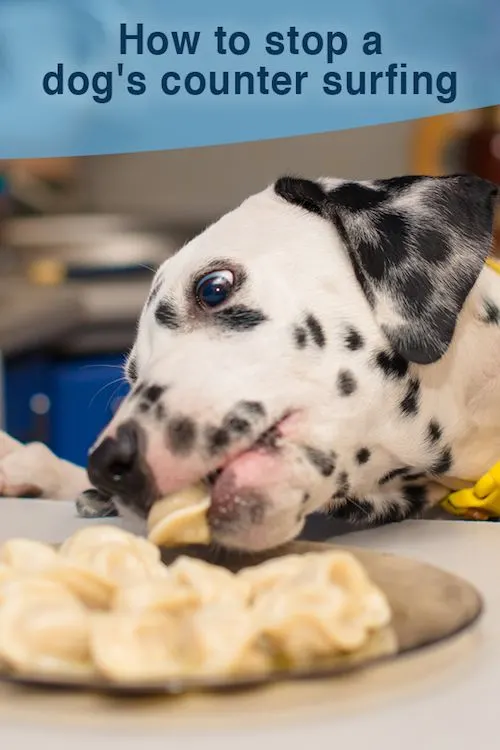
To prevent counter surfing in dogs, there are several preventive measures that owners can take. One of the most effective methods is to clear countertops and tables of any food or items that might tempt a curious pup. This means making sure that all food items are securely stored and not left unattended. Additionally, using deterrents such as childproof locks or covering countertops with aluminum foil can discourage dogs from jumping up.
Another preventive measure is the use of barriers. Baby gates can be placed in doorways, limiting access to the kitchen or dining area where counters are located. This helps to create a physical barrier that prevents dogs from reaching the countertops. Alternatively, teaching dogs to stay in a crate or designated area when unsupervised can also be helpful in preventing counter surfing.
By implementing these preventive measures, pet owners can significantly reduce the likelihood of their dogs engaging in counter surfing behavior.
Clearing countertops and tables
:strip_icc()/Stocksy_txp97ac6b6ffBx100_Medium_496405-5afc8aa6c5542e00365dd00d.jpg)
Clearing countertops and tables is a crucial step in preventing counter surfing behavior in dogs. By removing all tempting items from these surfaces, you can eliminate the opportunity for your dog to snatch food or other objects.
To start, make it a habit to clear and clean your countertops and tables after every use. This means promptly putting away any leftover food, dirty dishes, or food preparation items. Even a small crumb or scent of food can entice a curious dog.
Additionally, be mindful of where you store food items. Avoid leaving unattended food or snacks within reach of your dog. Opt for secure cabinets or pantry spaces to keep food out of sight and inaccessible.
By consistently clearing countertops and tables, you are removing the immediate temptation for your dog to engage in counter surfing. This is an essential step in setting your dog up for success and discouraging unwanted behaviors.
Using deterrents and barriers

Using deterrents and barriers can be an effective strategy in preventing counter surfing behavior in dogs. Deterrents are designed to make the act of jumping on countertops or tables unpleasant for your furry friend. One option is to use a pet-safe deterrent spray on surfaces that you want to keep off-limits. These sprays often have a bitter taste or unpleasant odor that discourages dogs from approaching the area.
Another effective deterrent is the use of noise-making devices. Placing bells or cans filled with coins on the edge of countertops or tables can startle dogs when they attempt to jump up. The sudden noise can discourage them from repeating the behavior.
In addition to deterrents, physical barriers can be employed to prevent access to areas where food is typically kept or where counter surfing is common. This can involve using baby gates or installing pet-specific barriers that block off the kitchen or dining area.
By using deterrents and barriers, you can create a physical and sensory deterrent for your dog, decreasing their motivation to engage in counter surfing.
Training Techniques

To address counter surfing behavior in dogs, effective training techniques can play a crucial role. One technique is teaching the "Leave it" command. This command teaches dogs to resist the urge to grab food from the countertop by redirecting their attention elsewhere. Start by showing the dog a treat in your hand, then close your hand and say "Leave it." Reward the dog with a different treat when they stop showing interest in the closed hand. Gradually transition to using objects on the countertop, rewarding the dog for leaving them alone.
Positive reinforcement is also essential. Rewarding desired behaviors, like staying away from the countertop or choosing a designated "place" to lay down, helps reinforce these behaviors. Praising and treating the dog when they make the right choice encourages them to continue behaving appropriately.
Consistency and reinforcement are paramount in training. Establishing a consistent routine where the dog receives rewards for good behavior helps solidify the desired habits. Additionally, rewarding alternative behaviors, such as playing with toys or chewing on designated items, provides the dog with appropriate outlets for their energy and attention.
By implementing these training techniques, owners can effectively address counter surfing behavior and foster a well-behaved and safe environment for their dogs.
Teaching the Leave it command
Teaching the Leave it command is an essential training technique that can help prevent counter surfing in dogs. This command teaches dogs to ignore or not touch objects that they are tempted to investigate or consume.
To start training your dog to leave items alone, you will need a treat that your dog finds highly desirable. Hold the treat in your closed hand and let your dog sniff and paw at it. As soon as your dog stops trying to get the treat, say "Leave it" and offer a different, more appropriate treat. Repeat this exercise several times, gradually increasing the time and distractions before rewarding your dog.
Once your dog is consistently responding to the command with the treat in your closed hand, you can move on to leaving items on the floor or low surfaces. Place an item your dog is likely to show interest in, such as a toy or a treat, and cover it with your hand. When your dog stops trying to get the item, say "Leave it" and reward them with a treat.
Consistency and patience are key when teaching the Leave it command. Gradually increase the difficulty of situations, such as placing tempting food on a countertop, and reinforce the command each time your dog successfully refrains from counter surfing. With practice, your dog will learn to respect boundaries and resist the temptation to explore forbidden surfaces.
Positive reinforcement for desired behavior
Positive reinforcement is a highly effective method for training dogs and promoting desired behaviors. When it comes to preventing counter surfing, positive reinforcement can be a valuable tool.
When your dog exhibits appropriate behavior, such as staying away from the countertops or leaving items alone, it's important to reward them. This can be done through praise, treats, or other rewards that your dog finds motivating. By consistently reinforcing these desired behaviors, you can help your dog understand what is expected of them.
For example, if your dog walks away from the countertop when commanded to "leave it," you can immediately offer a treat or verbal praise to reinforce their good behavior. Over time, your dog will associate staying away from the countertops with positive outcomes, making them less likely to engage in counter surfing.
Remember to be consistent with your reinforcement and use it in conjunction with other preventive measures. By combining positive reinforcement with clear communication and a proactive approach, you can effectively prevent counter surfing in your dog and create a harmonious living environment for both of you.
Consistency and Reinforcement
Consistency and reinforcement are key elements in preventing and addressing counter surfing in dogs. Dogs thrive on routine, so establishing a consistent routine is crucial. This includes consistently clearing countertops and tables of any food or tempting items, as well as consistently using deterrents and barriers to prevent access.
Reinforcement is also vital in shaping your dog's behavior. When teaching the "Leave it" command, it's important to consistently reward your dog for obeying and redirecting their attention to an appropriate behavior. Positive reinforcement, such as treats or praise, can help your dog understand what is expected of them.
Consistency and reinforcement should extend to all members of the household. Everyone must be on the same page regarding the rules and consequences for counter surfing to ensure your dog receives consistent messages.
By being consistent in your routines and reinforcing desired behaviors, you can effectively discourage counter surfing in your dog and promote a harmonious living environment.
Establishing a consistent routine
Establishing a consistent routine is essential when it comes to preventing counter surfing in dogs. Dogs thrive on structure and knowing what to expect each day. By creating a consistent routine, you can help reduce their desire to engage in this behavior.
One aspect of establishing a routine is ensuring that your dog is receiving regular and balanced meals. By feeding them at specific times throughout the day, you can help satisfy their hunger and reduce the temptation to search for food on the countertops.
In addition to regular meals, it's important to schedule daily exercise and mental stimulation for your dog. A tired and mentally stimulated dog is less likely to engage in counter surfing as they will be focused and content.
Consistency also extends to the training techniques you use with your dog. Ensure that everyone in your household is using the same commands and reinforcement strategies. This will help reinforce the desired behavior and minimize confusion for your dog.
By establishing a consistent routine, you will create a sense of predictability and stability for your dog, reducing their chances of engaging in counter surfing.
Rewarding alternative behaviors

When it comes to preventing counter surfing in dogs, rewarding alternative behaviors is an essential part of the training process. Instead of focusing solely on stopping the undesirable behavior, it's important to teach your dog what they should be doing instead.
For example, if your dog typically jumps up onto the counter looking for food, you can redirect their attention to a designated area where they are allowed to be, such as a cozy dog bed or a designated play area. When they choose to go to this area instead of counter surfing, be sure to reward them with praise, treats, or even a favorite toy.
By consistently rewarding and reinforcing this alternative behavior, your dog will start to associate the desired behavior with positive outcomes. This will create a stronger motivation for them to choose the alternative option rather than engaging in counter surfing.
Remember to be patient and consistent in your training efforts. Consistently rewarding alternative behaviors and reinforcing the desired behavior will help your dog understand what is expected of them, leading to a harmonious and well-behaved furry companion.
Managing Temptations

To effectively prevent counter surfing in dogs, it is important to manage temptations and make sure the environment is not enticing for them. Properly storing and disposing of food is crucial in this regard. Keeping food items securely stored in sealed containers or in cabinets out of reach can eliminate the temptation for dogs to jump onto countertops or tables. Additionally, it is essential to promptly dispose of any food waste or leftovers in a secure trash can that cannot be accessed by your furry friend.
In addition to food management, it is important to keep countertops clean and clear. Any lingering food smells or crumbs can attract dogs and encourage them to explore the forbidden territory. Regularly wiping down countertops with pet-safe cleaning products and ensuring that no food residue is left behind can help deter dogs from engaging in counter surfing behavior.
By actively managing the environment, dog owners can significantly reduce the chances of their pets participating in counter surfing activities and create a safe and unappealing space for their furry companions.
Properly storing and disposing of food

Properly storing and disposing of food is crucial in preventing counter surfing in dogs. By taking proactive measures, you can minimize their access to tempting treats and reduce the chances of them engaging in this unwanted behavior.
When it comes to storing food, opt for airtight containers that are inaccessible to your dog. This will prevent them from smelling and reaching the contents. Additionally, ensure that the containers are locked securely to prevent any accidental spills or openings.
When disposing of food, be mindful of how you discard it. Avoid throwing scraps or leftovers in the trash where your dog can easily access them. Instead, seal them in a sturdy bag or container and either dispose of them outside or in a secure trash bin.
By properly storing and disposing of food, you eliminate the enticing smells that can trigger your dog's counter surfing behavior. This, combined with training and a consistent routine, will help to effectively prevent counter surfing and maintain a peaceful and well-behaved dog in your home.
Keeping countertops clean and clear

To prevent counter surfing in dogs, it is important to keep countertops clean and clear of any tempting items. Dogs are naturally curious creatures, and a scent or sight of food on the counter can be irresistible to them. Therefore, it is crucial to establish a habit of tidiness and cleanliness in the kitchen.
One effective strategy is to ensure that all food items are securely stored away in cabinets or the refrigerator. Leftovers or tempting snacks should not be left out on the counter where they can easily attract a dog's attention. Additionally, it is important to properly dispose of food waste in a secure trash can with a lid. This helps to eliminate any lingering smells that can entice dogs to explore the countertops.
Regular cleaning of the countertops is also essential. Any crumbs or food residues left behind can serve as a magnet for a dog looking for an easy snack. Wiping down the surfaces with a pet-safe cleaner can help remove any lingering odors and keep the countertops free from food debris.
By keeping countertops clean and clear, dog owners can significantly reduce the temptation for their furry friends to engage in counter surfing.
Addressing Underlying Issues

Addressing Underlying Issues
When it comes to counter surfing in dogs, it's important to address any underlying issues that may be contributing to this behavior. Two common underlying issues that can lead to counter surfing are separation anxiety and boredom.
Separation anxiety can cause a dog to search for comfort or entertainment while their owner is away. The countertops and tables in the kitchen may become attractive targets for dogs experiencing this anxiety. It's crucial to address separation anxiety through behavioral modification techniques and ensuring the dog feels secure and comfortable when left alone.
Boredom is another potential cause of counter surfing. Dogs with excess energy or a lack of mental stimulation may seek out food or other items on the countertop as a way to alleviate their boredom. Providing plenty of physical exercise and mental enrichment activities, such as puzzle toys or interactive games, can help curb this behavior.
By addressing these underlying issues, such as separation anxiety and boredom, owners can help prevent and reduce counter surfing behaviors in their dogs.
Separation anxiety and counter surfing
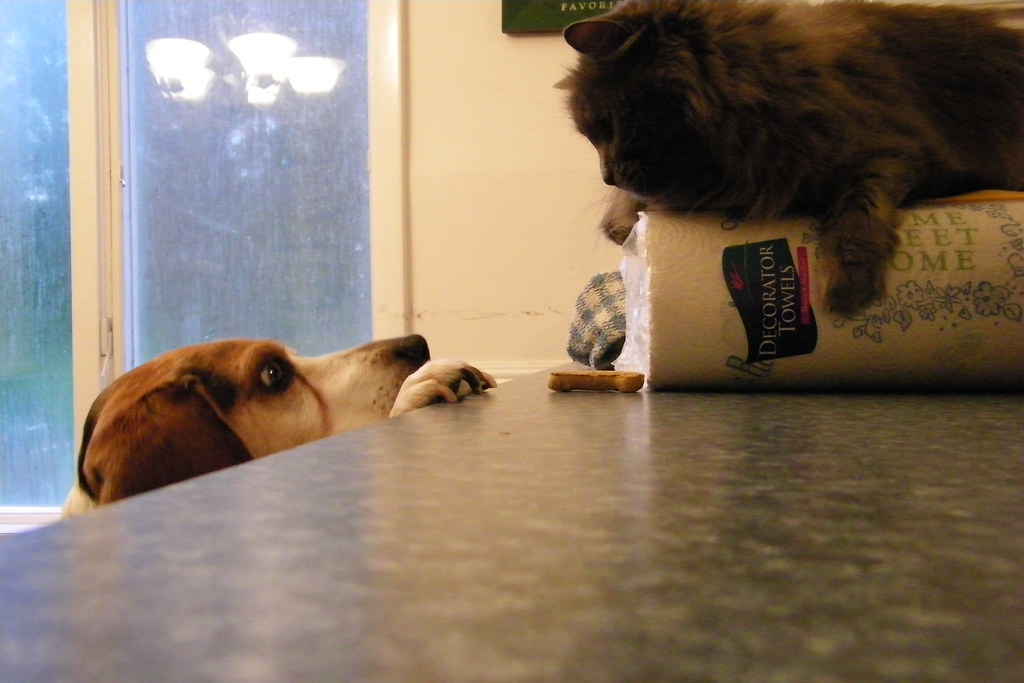
Separation anxiety can also play a significant role in dogs engaging in counter surfing behavior. When dogs experience separation anxiety, they can become stressed and anxious when left alone, leading them to seek comfort or stimulation in different ways. Counter surfing may be one way for them to alleviate their anxiety.
When dogs are left alone, they may feel bored, lonely, or anxious, driving them to engage in destructive or attention-seeking behaviors. Counter surfing can serve as a way for them to occupy their time and alleviate their feelings of distress.
To address counter surfing caused by separation anxiety, it is essential to address the underlying anxiety issues. This can be done through desensitization and counterconditioning techniques, gradually getting the dog used to being alone and associating it with positive experiences. Furthermore, providing mental stimulation through interactive toys or puzzles can help keep them occupied and reduce their need to engage in counter surfing behavior.
It is crucial to seek guidance from a professional dog trainer or behaviorist to develop a comprehensive plan to address separation anxiety and counter surfing effectively. By addressing the underlying issue of separation anxiety, dogs can overcome the behavior and find healthier ways to cope with being alone.
Boredom and counter surfing

Boredom is another common underlying issue that can lead to counter surfing in dogs. When dogs are left alone for long periods of time without any mental or physical stimulation, they may resort to exploring the kitchen counters in search of something interesting or rewarding.
A bored dog may see counter surfing as a way to occupy themselves and alleviate their boredom. The act of searching for food or engaging in forbidden behaviors can provide them with a temporary source of entertainment.
To address this issue, it is important to ensure that your dog is provided with plenty of mental and physical exercise on a daily basis. This can include activities such as interactive toys, puzzle feeders, and regular walks or playtime.
Additionally, providing your dog with proper mental enrichment, such as training sessions or nose work activities, can help prevent them from seeking out excitement in the form of counter surfing.
By addressing boredom in your dog's daily routine, you can help curb their desire to engage in counter surfing behaviors. With the right stimulation, your dog will be less likely to resort to searching for rewards on the kitchen countertops.
Conclusion
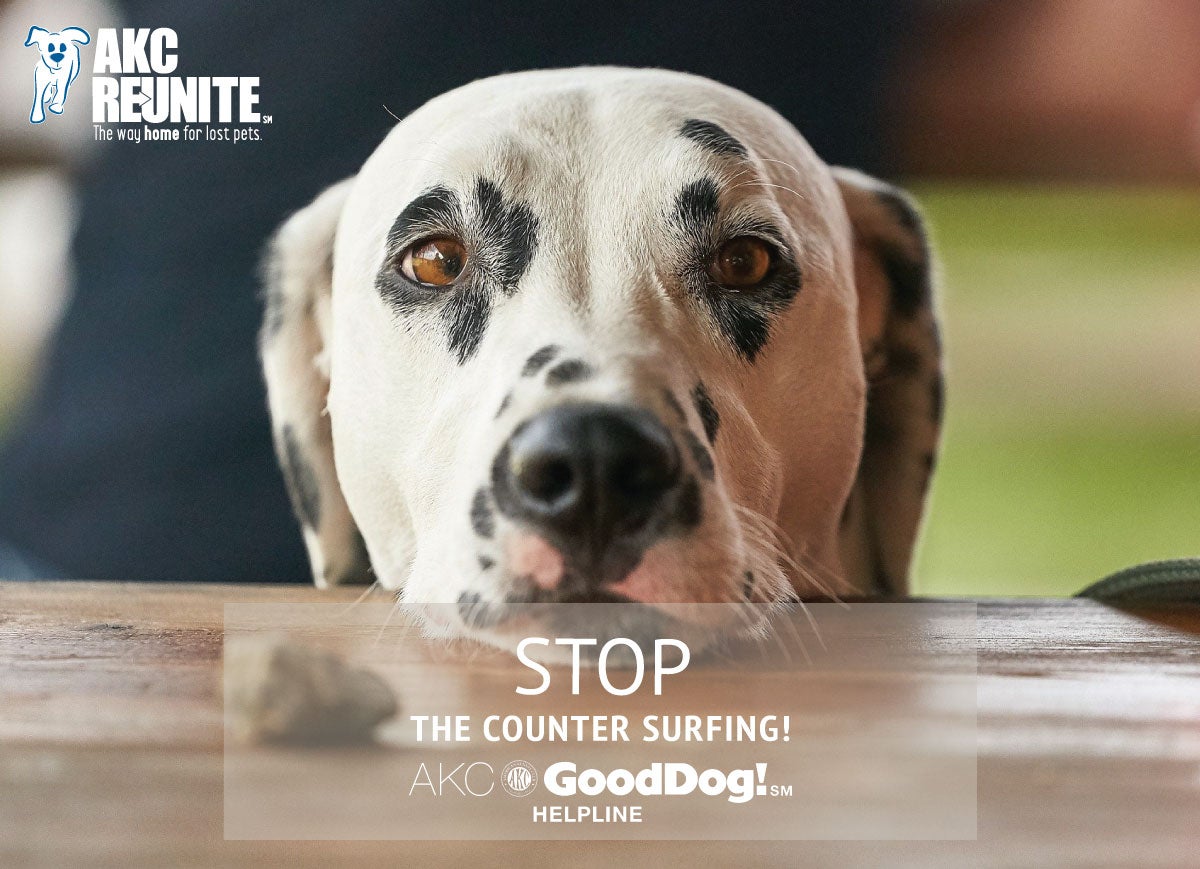
In conclusion, understanding and preventing counter surfing in dogs is crucial for the safety and well-being of both your furry friend and your household. Counter surfing can be a natural instinct and can stem from various motivations, such as food-driven behavior or a desire for attention. By identifying common triggers and implementing preventive measures, you can significantly reduce the likelihood of your dog engaging in this behavior.
Training techniques, such as teaching the "leave it" command and using positive reinforcement for desired behavior, can further deter counter surfing. Consistency and reinforcement are key in establishing a routine and rewarding alternative behaviors. Managing temptations by properly storing and disposing of food, as well as keeping countertops clean and clear, can help eliminate opportunities for counter surfing.
It is important to address any underlying issues that may be contributing to counter surfing, such as separation anxiety or boredom. By addressing these issues, you can help minimize the chances of your dog resorting to counter surfing for comfort or entertainment.
Overall, by taking these steps, you can ensure a safe environment for your dog and maintain a harmonious relationship with your furry companion. Continued diligence and adherence to these preventive measures will contribute to long-lasting success in preventing counter surfing in dogs.
Benefits of preventing counter surfing in dogs

Preventing counter surfing in dogs can have numerous benefits for both the dog and their human companions. Firstly, it promotes the safety and well-being of the dog. Dogs who engage in counter surfing are at risk of ingesting harmful substances such as toxic foods, cleaning chemicals, or even sharp objects. By preventing counter surfing, owners can protect their furry friends from potential dangers and avoid costly vet bills.
Additionally, preventing counter surfing helps to maintain a harmonious household. Dogs who snatch food from countertops can create frustration and tension among family members. By setting clear boundaries and managing temptations, owners can create a peaceful and enjoyable environment for everyone.
Preventing counter surfing can also improve the dog's behavior and impulse control. Teaching dogs to resist the urge to snatch food reinforces their self-control and discipline. This can have a positive impact on their overall obedience and responsiveness to commands.
Overall, by actively preventing counter surfing in dogs, owners can ensure the safety of their four-legged companions, maintain a harmonious household, and help their dogs develop better self-control and obedience skills.
Tips for ongoing success

To ensure ongoing success in preventing counter surfing in dogs, it is important to follow a few tips and strategies. Here are some key recommendations:
- Consistent reinforcement: Continue to reinforce the desired behavior of your dog by consistently using the training techniques and commands learned. Consistency is the key to long-term success.
- Supervision: Always keep an eye on your dog, especially when food or tempting items are within reach. Supervise their behavior and intervene if they show any signs of counter surfing.
- Environmental management: Make sure to keep countertops and tables clear of any food or enticing smells. Store food and other potential temptations securely to create a safe and unappealing environment for your dog.
- Mental and physical stimulation: Provide your dog with plenty of mental and physical exercise to prevent boredom, which can lead to counter surfing. Engage in regular play sessions, puzzle toys, and walks to keep them mentally and physically stimulated.
- Seek professional help if needed: If counter surfing persists despite your efforts, consult with a professional dog trainer or behaviorist who can provide personalized guidance and solutions to address any underlying issues.
By following these tips, you can enjoy a counter surfing-free household and maintain a happy and well-behaved dog.




0 Comments